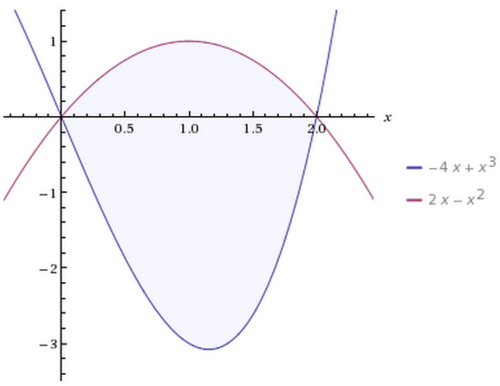Science:Math Exam Resources/Courses/MATH103/April 2010/Question 02
{{#incat:MER QGQ flag|{{#incat:MER QGH flag|{{#incat:MER QGS flag|}}}}}}
• Q1 (a) • Q1 (b) • Q1 (c) • Q1 (d) • Q1 (e) • Q1 (f) • Q1 (g) • Q1 (h) • Q2 • Q3 (a) • Q3 (b) • Q4 (a) • Q4 (b) • Q4 (c) • Q5 (a) • Q5 (b) • Q6 (a) • Q6 (b) • Q7 (a) • Q7 (b) • Q7 (c) • Q8 •
Question 02 |
|---|
|
Calculate the area of the bounded region enclosed by the curves for x ≥ 0. |
|
Make sure you understand the problem fully: What is the question asking you to do? Are there specific conditions or constraints that you should take note of? How will you know if your answer is correct from your work only? Can you rephrase the question in your own words in a way that makes sense to you? |
|
If you are stuck, check the hint below. Consider it for a while. Does it give you a new idea on how to approach the problem? If so, try it! |
Hint |
|---|
|
Find the intersection points of the two functions. |
|
Checking a solution serves two purposes: helping you if, after having used the hint, you still are stuck on the problem; or if you have solved the problem and would like to check your work.
|
Solution |
|---|
|
To find the limits of the integral that calculates the area, we need to find the intersection points of the two functions and and so we set the functions equal. That means and leads to So, we find that the functions intersect three times at . However, we have a constraint that and so we will only be concerned with the interval [0,2]. We need to integrate the function or (depending on which is the upper and which is the lower curve). Now we check which function is the upper function. One way to do this is to simply plug in any point in the interval and compare the function values. On [0,2] we choose x = 1 and get f(1) = -3, g(1)=1. Hence g > f on [0,2].
Therefore the area of A is 16/3. |
{{#incat:MER CT flag||
}}











![{\displaystyle {\begin{aligned}\ A&=\int _{0}^{2}(g(x)-f(x))dx\\&=\int _{0}^{2}(-x^{2}+2x-x^{3}+4x)dx\\&=\left[-{\frac {x^{3}}{3}}+6{\frac {x^{2}}{2}}-{\frac {x^{4}}{4}}\right]_{0}^{2}\\&=-{\frac {2^{3}}{3}}+6{\frac {2^{2}}{2}}-{\frac {2^{4}}{4}}-0\\&={\frac {16}{3}}\end{aligned}}}](https://wiki.ubc.ca/api/rest_v1/media/math/render/svg/66c14777cf064f81db3b965fd847ca1c60f4c61f)

